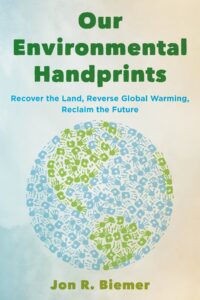 Thank you for this opportunity to share some insights from my book, Our Environmental Handprints: Recover the Land, Reverse Global Warming, Reclaim the Future.
Thank you for this opportunity to share some insights from my book, Our Environmental Handprints: Recover the Land, Reverse Global Warming, Reclaim the Future.
What is the Environmental Handprint and why should I care about it?
The Handprint is deceptively simple. If you do good, you have created a Handprint. If you do good for the environment, like planting a tree or shifting to paperless bill paying, you create an Environmental Handprint.
I have been developing the Environmental Handprint since 2007.
Back then, I was frustrated by my inability to reduce my Ecological Footprint more than few percent. Then I remembered a book I read decades earlier. Its message: creativity has much more potential than problem solving. Creativity allows us to go beyond the boundaries and blinders we tend to assume as part of the problem. I can give the customer his or her money back or I can give the customer something he’ll cherish instead. (I brag about Patagonia rain parka every chance I get.) Also, the image of a handprint carved in rock (a petroglyph) evoked a feeling of connection. To me it represents the ways of a people who were in touch with nature.
The Handprint functions like a wrench, with as many variations. Serving a tasty plant-based meal tweaks the food industry with the exactness of needle-nosed pliers. Eco-remodeling your home applies a pipe wrench to the carbon and water Footprints of present and future occupants. Buying an electric car is like employing an adjustable open-end wrench to the auto industry. Putting a price on carbon, either through a tax or a cap with trading options, can be as effective as vice grips. To enact a constitutional amendment to curb the excesses of corporate personhood we’ll need a wrench capable of turning off a fire hydrant.
The secret to the Handprint’s effectiveness lies not in its definition or even in its calculation but rather in its potential to inspire, validate and motivate life-affirming change.
Others have, in their own ways, discovered the usefulness of the Handprint. The Center for Environmental Education in India used the Handprint as the logo for an environmental conference. Greg Norris in Maine encourages students and consulting clients to become NetPositive. That is, make your Handprint greater than your Footprint. Professor Rocky Rohwedder in California emphasizes strategies that improve the social, economic and environmental wellbeing of a community. LUT university in Finland studies ways to reliably quantify a carbon Handprint. The Handprint is an idea whose time has come.
How do you make your own Environmental Handprint?
I like living in a single-family house. I take to a bath daily. I’m likely to stay in this country, with its giant infrastructure and military Footprints. You may want to keep your job to feed your family. Stepping away from your career to save the whales could be deal breaker. We all have reasons for staying the course and explaining why we cannot do something. Yes, and…
Your situation also suggests your potential. If you have a good job, donate some of that income to an organization that is committed to creating Handprints. Make it an automatic monthly donation. How about the World Wildlife Fund? How about Friends of _______ (fill in the blank with your favorite river or park)? Or the Deep South Center for Environmental Justice? If you have time on your hands, volunteer cleaning up your local river. Call it networking. If you are a parent, read environmental books to your children. Check out winners of Santa Monica Library’s Green Prize for Sustainable Literature. My primary care physician eliminated disposables from his office lunchroom. My wife convinced me to include a section on eliminating disposables in my book.
I provide Handprint opportunities at the end of each chapter, 178 in all.
Overwhelmed? Draw an outline of your hand on a sheet of paper. Jot down just five eco-actions you are willing to consider – or have already been considering – one for each finger. Maybe something simple, like going meatless for a single Monday, more if you can. How about exercising your generosity with a donation of money or gently used clothing? Maybe your house needs an eco-upgrade, like screwing in LED bulbs. How about seeking earth-friendly employment (hint, bus driving counts)? Finally, consider a cooperative aspiration, like joining a car pool or tool exchange. Or inviting professional associates to brainstorm eco-opportunities in your profession.
Share your work of art with someone, anyone. Check back with it in six months. Revise and update as feels appropriate. You will be amazed by what you end up doing, just by expressing intentions and giving yourself periodic feedback.
Seriously, that is all I’m asking anyone to do. The rest comes from within you.
Your subtitle makes a bold claim: Recover the Land, Reverse Global Warming, Reclaim the Future. Please explain.
We have made some impressive environmental progress, despite the fact that Climate Change is already melting glaciers and fueling Category 5 hurricanes. We outlawed DDT and rescued the bald eagle from extinction. Every nation on earth agreed to curtail chlorofluorocarbons which were depleting ozone in the ionosphere. We now have 63 national parks; the world has over 3,000 by one count. We have cleaned up 1,200 superfund sites. The list goes on and on. These are changes in the system. I call these collective Handprints.
More accomplishments of that magnitude are well within our grasp. (Yes, pun intended.) Say, within this decade.
Electric cars will become dominant in the marketplace. The United Kingdom will ban the sale of new combustion-engine vehicles by 2030. General Motors sells the Chevrolet Bolt now and is investing billions of dollars in developing a fleet of electric vehicles worldwide. Incidentally, electric cars are four times as efficient as gasoline fueled vehicles.
Wind and solar energy will become our dominant source of electric power. Over the last decade (2010-2019) solar (photovoltaic) power costs declined by 82 percent and land-based wind power declined by 39 percent. Off-shore wind power is now reliable. According to the International Renewable Energy Agency, “Nearly two-thirds of all new power generation capacity added in 2018 was from renewables, led by emerging and developing economies.” Maturing and scaling of batteries and distributed resources (including efficiency and demand-side management) are effectively dealing with the vagaries of weather.
Agriculture, now a major source of carbon emissions, can be transformed into a major carbon-sequestration resource. Regenerative farming has been demonstrated around the world. Strategies include: mob grazing of cattle, developing perennial grains (which don’t require annual plowing), and the establishment of a Regenerative Organic Certification.
My book makes a dozen such assertions that the game really is changing, each grounded in demonstrated technologies and governance policies. So, if change concerns you, beware. On the other hand, a better world is not a sure thing. There is a lot of work to be done. You are the expert on how to best make use of your circumstance, resources and talents. Think of Our Environmental Handprints: Recover the Land, Reverse Global Warming, Reclaim the Future as a catalyst. Let’s get to it.
BIO:
 Jon Biemer has more than forty years of experience working on sustainability-creating initiatives. Biemer is a mechanical engineer and holds a certificate in Process-oriented Psychology. He started Creating Sustainability as a sole-proprietor Organizational Development consulting practice in 2008. He is the author of Our Environmental Handprints.
Jon Biemer has more than forty years of experience working on sustainability-creating initiatives. Biemer is a mechanical engineer and holds a certificate in Process-oriented Psychology. He started Creating Sustainability as a sole-proprietor Organizational Development consulting practice in 2008. He is the author of Our Environmental Handprints.
Prior to starting his own practice, Biemer served 23 years with Bonneville Power Administration (BPA) in the Energy Efficiency Group, coordinating research and managing energy efficiency programs. He was active in both the Association of State Energy Research and Technology Transfer Institutions (ASERTTI) and the Solar Rating and Certification Council (SRCC). While at BPA, Biemer led the Resource Supply Expansion Program (RSEP), an initiative to demonstrate and deploy energy efficient technologies and practices into the marketplace. Over twenty organizations participated in thirteen projects. RSEP set the stage for large windfarms in the Pacific Northwest.
After leaving BPA, Mr. Biemer advised Portland, Oregon’s Green Investment Fund program, which encouraged innovation in leading-edge sustainable buildings. He also advised the Portland Water Bureau, reviewing environmentally related activities. From 2010 to 2013, Jon Biemer served as President of the Earth & Spirit Council (E&S), which bridges environmentalism and spirituality. E&S has invited more than fifty Native American elders to share their traditional teachings before they are lost to a developing world. In 2009, Mr. Biemer published his first article regarding the Environmental Handprint (the good we do).
Biemer strives to live sustainably. He and his wife, Willow, gave their home an eco-retrofit, which was featured in Portland, Oregon’s 2007 Build It Green Tour. Features include:
- Low-VOC (Volatile Organic Carbons) paint.
- Extra insulation under the roof and floor.
- LED lighting everywhere.
- Recovered house parts, including cupboards, a sink and doors.
- On-demand water heaters in lieu of energy-wasting tank water heaters.
- Energy Star dishwasher and high-efficiency furnace.
- Moveable drying racks instead of a power consuming clothes dryer.
Jon and Willow create food forests in lieu of lawns wherever they live. They raise raspberries, mulberries, plums, apples, quince, onions, jalapeno peppers, green beans, zucchini, kale, lettuce, and a variety of herbs. They eat healthy for the planet – supplementing their garden with organic food from farmers markets and eco-conscious grocers.
They work closely with the Johnson Creek Watershed Council to remove invasive plants (especially English ivy), and plant native species. Likewise, Jon and Willow participate in sustainable community functions such the Free Cycle Network, Repair Cafes and urban gleaning.